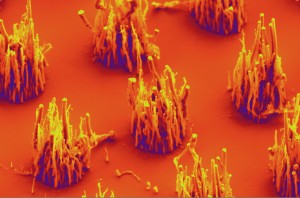In this piece I’m mashing together two items, both involving cockroaches and neuroscience and, in one case, disaster recovery. The first item concerns research at the North Carolina State University where video game techniques are being used to control cockroaches. From the June 25, 2013 news item on ScienceDaily,
North Carolina State University researchers are using video game technology to remotely control cockroaches on autopilot, with a computer steering the cockroach through a controlled environment. The researchers are using the technology to track how roaches respond to the remote control, with the goal of developing ways that roaches on autopilot can be used to map dynamic environments — such as collapsed buildings.
The researchers have incorporated Microsoft’s motion-sensing Kinect system into an electronic interface developed at NC State that can remotely control cockroaches. The researchers plug in a digitally plotted path for the roach, and use Kinect to identify and track the insect’s progress. The program then uses the Kinect tracking data to automatically steer the roach along the desired path.
The June 25, 2013 North Carolina State University news release, which originated the news item, reveals more details,
The program also uses Kinect to collect data on how the roaches respond to the electrical impulses from the remote-control interface. This data will help the researchers fine-tune the steering parameters needed to control the roaches more precisely.
“Our goal is to be able to guide these roaches as efficiently as possible, and our work with Kinect is helping us do that,” says Dr. Alper Bozkurt, an assistant professor of electrical and computer engineering at NC State and co-author of a paper on the work.
“We want to build on this program, incorporating mapping and radio frequency techniques that will allow us to use a small group of cockroaches to explore and map disaster sites,” Bozkurt says. “The autopilot program would control the roaches, sending them on the most efficient routes to provide rescuers with a comprehensive view of the situation.”
The roaches would also be equipped with sensors, such as microphones, to detect survivors in collapsed buildings or other disaster areas. “We may even be able to attach small speakers, which would allow rescuers to communicate with anyone who is trapped,” Bozkurt says.
Bozkurt’s team had previously developed the technology that would allow users to steer cockroaches remotely, but the use of Kinect to develop an autopilot program and track the precise response of roaches to electrical impulses is new.
The interface that controls the roach is wired to the roach’s antennae and cerci. The cerci are sensory organs on the roach’s abdomen, which are normally used to detect movement in the air that could indicate a predator is approaching – causing the roach to scurry away. But the researchers use the wires attached to the cerci to spur the roach into motion. The wires attached to the antennae send small charges that trick the roach into thinking the antennae are in contact with a barrier and steering them in the opposite direction.
Meanwhile for those of us without laboratories, there’s the RoboRoach Kickstarter project,
Our Roboroach is an innovative marriage of behavioral neuroscience and neural engineering. Cockroaches use the antennas on their head to navigate the world around them. When these antennas touch a wall, the cockroach turns away from the wall. The antenna of a cockroach contains neurons that are sensitive to touch and smell.
…
The backpack we invented communicates directly to the [cockroach’s] neurons via small electrical pulses. The cockroach undergoes a short surgery (under anesthesia) in which wires are placed inside the antenna. Once it recovers, a backpack is temporarily placed on its back.
…
When you send the command from your mobile phone, the backpack sends pulses to the antenna, which causes the neurons to fire, which causes the roach to think there is a wall on one side. The result? The roach turns! Microstimulation is the same neurotechnology that is used to treat Parkinson’s Disease and is also used in Cochlear Implants.
…
This product is not a toy, but a tool to learn about how our brains work. Using the RoboRoach, you will be able to discover a number of interesting things about nature:
Neural control of Behaviour: First and foremost you will see in real-time how the brain respondes to sensory stimuli.
Learning and Memory: After a few minutes the cockroach will stop responding to the RoboRaoch microstimulation. Why? The brain learns and adapts. That is what brains are designed to do. You can measure the time to adaptation for various stimulation frequencies.
Adaptation and Habituation: After placing the cockroach back in its homecage, how long does it take for him to respond again? Does he adapt to the stimuli more quickly?
Stimuli Selection: What range of frequencies works for causing neurons to fire? With this tool, you will be able to select the range of stimulation to see what works best for your prep. Is it the same that is used by medical doctors stimulating human neurons? You will find out.
Effect of Randomness: For the first time ever… we will be adding a “random” mode to our stimulus patterns. We, as humans, can adapt easily to periodic noises (the hum a refrigerator can be ignored, for example). So perhaps the reason for adaptation is our stimulus is periodic. Now you can select random mode and see if the RoboRoach adapts as quickly.. or at all!
Backyard Brains (mentioned here in my March 28, 2012 posting* about neurons, dance, and do-it-yourself neuroscience; another mashup), the organization initiating this Kickstarter campaign, has 13 days left to make its goal of $10,000 (as of today, June 26, 2013 at 10:00 am PDT, the project has received $9,774 in pledges).
Pledges can range from $5 to $500 with incentives ranging from a mention on their website to delivery of RoboRoach Kits (complete with cockroaches, only within US borders).
This particular version of the RoboRoach project was introduced by Greg Gage at TEDGlobal 2103. Here’s what Karen Eng had to say about the presentation in her June 12, 2013 posting on the TED [technology, entertainment, design] blog,
Talking as fast and fervently as a circus busker, TED Fellow Greg Gage introduces the world to RoboRoach — a kit that allows you create a cockroach cyborg and control its movements via an iPhone app and “the world’s first commercially available cyborg in the history of mankind.”
“I’m a neuroscientist,” says Gage, “and that means I had to go to grad school for five years just to ask questions about the brain.” This is because the equipment involved is so expensive and complex that it’s only available in university research labs, accessible to PhD candidates and researchers. But other branches of science don’t have this problem — “You don’t have to get a PhD in astronomy to get a telescope and study the sky.”
Yet one in five of us will be diagnosed with a neurological disorder — for which we have no cures. We need more people educated in neuroscience to investigate these diseases. That’s why Gage and his partners at Backyard Brains are developing affordable tools that allow educators to teach electrophysiology from university down to the fifth grade level.
…
As he speaks, he and his partner, Tim Marzullo, release a large South American cockroach wearing an electronic backpack — which sends an electrical current directly into the cockroach’s antenna nerves — onto the table on stage. A line of green spikes appear, accompanied by a sound like rain on a tent or popcorn popping. “The common currency of the brain are the spikes in the neurons,” Gage explains. “These are the neurons that are inside of the antenna, but that’s also what your brain sounds like. Your thoughts, your hopes, your dreams, all encoded into these spikes. People, this is reality right here — the spikes are everything you know!” As Greg’s partner swipes his finger across his iPhone, the RoboRoach swerves left and right, sometimes erratically going in a full confused circle.
So why do this? “This is the exact same technology that’s used to treat Parkinson’s disease and make cochlear implants for deaf people. If we can get these tools into hands of kids, we can start the neurological revolution.”
After Gage’s talk, Chris Anderson asks about the ethics of using the cockroaches for these purposes. Gage explains that this is microstimulation, not a pain response — the evidence is that the roach adapts quickly to the stimulation. (In fact, some high school students have discovered that they can control the rate of adaptation in an unusual way — by playing music to the roaches over their iPods.) After the experiment, he says, the cockroaches are released to go back to do what cockroaches normally do. So don’t worry — no animals were irretrievably harmed in the making of this TED talk.
Anya Kamenetz in her June 7, 2013 article for Fast Company about the then upcoming presentation also mentions insect welfare,
Attaching the electronic “backpack” to an unwitting arthropod is not for the squeamish. You must sand down the top of the critter’s head in order to attach a plug, “Exactly like the Matrix,” says Backyard Brains cofounder Greg Gage. Once installed, the system relays electrical impulses over a Bluetooth connection from your phone to the cockroach’s brain, via its antennae. …
…
Gage claims that he has scientific proof that neither the surgery nor the stimulation hurts the roaches. The proof, according to Gage, is that the stimulation stops working after a little while as the roaches apparently decide to ignore it.
Kamenetz goes on to note that this project has already led to a discovery. High school students in New York City found that cockroaches did not habituate to randomized electrical signals as quickly as they did to steady signals. This discovery could have implications for treatment of diseases such as Parkinson’s.
The issue of animal use/welfare vis à vis scientific experiments is not an easy one and I can understand why Gage might be eager to dismiss any suggestions that the cockroaches are being hurt. Given how hard it is to ignore pain, I am willing to accept Gage’s dismissal of the issue until such time as he is proven wrong. (BTW, I am curious as to how one would know if a cockroach is experiencing pain.)
I have one more thought for the road. I wonder whether the researchers at North Carolina State University are aware of the RoboRoach work and are able to integrate some of those findings into their own research (and vice versa).
*’March 28, 2013′ corrected to ‘March 28, 2012’ on Oct. 9, 2017.

